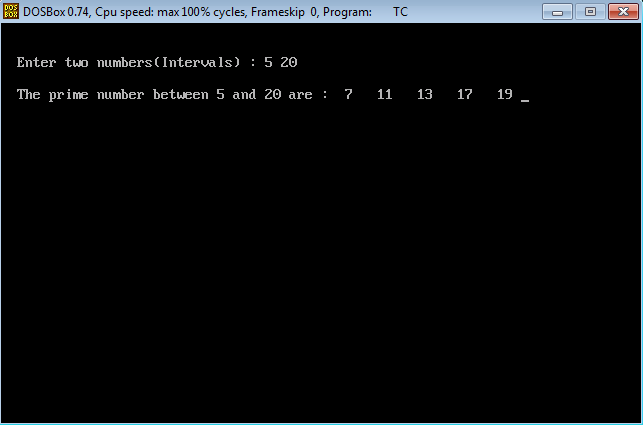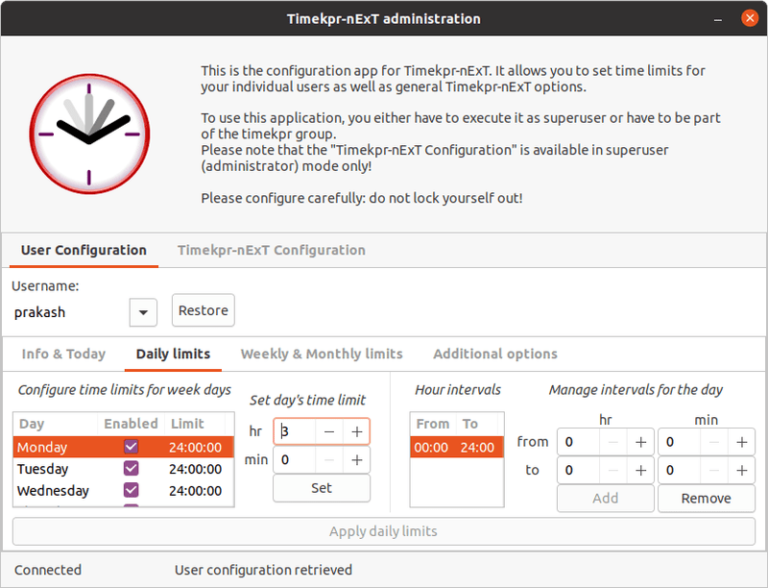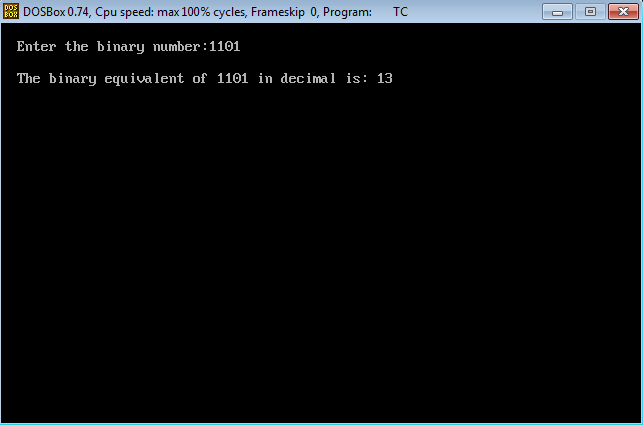To write a program to display Prime Numbers between Two Intervals we should know how to find a Number is Prime Number or Not?
To find a Number is Prime Number or Not, you can check out the following link:
C program to find a Number is Prime Number or Not
Program code to display Prime Numbers between Two Intervals:
/* Program to display Prime numbers between two Intervals */
#include<stdio.h>
#include<conio.h>
#include<math.h> void main()
{ int n, i, j, min, max, flag=0; clrscr(); printf("n Enter two numbers(Intervals) : "); scanf("%d%d",&min,&max); printf("n The prime numbers between %d and %d are :",min,max); for(i=min+1;i<max;i++) { flag=0; for(j=2;j<=sqrt(i);j++) //Loop to check whether 'i' (number) is divisible by any number between 2 and sqrt(i) { if(i%j==0) { flag=1; break; } } /* if condition to check and print if the Number is Prime Number */ if (flag==0) { printf(" %d ",i); } } getch();
}
Working:
- First the computer reads two numbers (Intervals) from the user.
- Then using outer for loop the numbers between the intervals are take one by one.
- Then using inner for loop it checks whether the number is prime number or not.
- Then if condition is used to check and print if the number is prime number.
- Thus all the prime numbers are printed.
Step by Step working of the above Program Code:
- Let us assume that a user enters the numbers as 5 and 20.
- It assigns the value of min=5 and max=20.
- It assigns the value of i=min+1 (ie. i=6) and the loop continues till the condition of the outer for loop is true.
3.1. i<max (6<20) outer for loop condition is true
It assigns flag=0 , j=2
3.1.1. j<=sqrt(i) (2<=√6) inner for loop condition is true
i%j==0 (6%2==0) if condition is true
It assigns flag=1
breaks the loop and comes out of the inner for loop
flag==0 (1==0) if condition is false
So it goes for next iteration of outer for loop.
i++ (i=i+1) So i=7
3.2. i<max (7<20) outer for loop condition is true
It assigns flag=0 , j=2
3.2.1. j<=sqrt(i) (2<=√7) inner for loop condition is true
i%j==0 (7%2==0) if condition is false
j++ (j=j+1) So j=3
3.2.2. j<=sqrt(i) (3<=√7) inner for loop condition is false
It comes out of the inner for loop.
flag==0 (0==0) if condition is false
So it prints 7 and goes for next iteration of outer for loop.
i++ (i=i+1) So i=8
3.3. i<max (8<20) outer for loop condition is true
It assigns flag=0 , j=2
3.3.1. j<=sqrt(i) (2<=√8) inner for loop condition is true
i%j==0 (8%2==0) if condition is true
It assigns flag=1
breaks the loop and comes out of the inner for loop
flag==0 (1==0) if condition is false
So it goes for next iteration of outer for loop.
i++ (i=i+1) So i=9
3.4. i<max (9<20) outer for loop condition is true
It assigns flag=0 , j=2
3.4.1. j<=sqrt(i) (2<=√9) inner for loop condition is true
i%j==0 (9%2==0) if condition is false
j++ (j=j+1) So j=3
3.4.2. j<=sqrt(i) (3<=√9) inner for loop condition is true
i%j==0 (9%3==0) if condition is true
It assigns flag=1
breaks the loop and comes out of the inner for loop
flag==0 (1==0) if condition is false
So it goes for next iteration of outer for loop.
i++ (i=i+1) So i=10
3.5. i<max (10<20) outer for loop condition is true
It assigns flag=0 , j=2
3.5.1. j<=sqrt(i) (2<=√10) inner for loop condition is true
i%j==0 (10%2==0) if condition is true
It assigns flag=1
breaks the loop and comes out of the inner for loop
flag==0 (1==0) if condition is false
So it goes for next iteration of outer for loop.
i++ (i=i+1) So i=11
3.6. i<max (11<20) outer for loop condition is true
It assigns flag=0 , j=2
3.6.1. j<=sqrt(i) (2<=√11) inner for loop condition is true
i%j==0 (11%2==0) if condition is false
j++ (j=j+1) So j=3
3.6.2. j<=sqrt(i) (3<=√11) inner for loop condition is true
i%j==0 (11%3==0) if condition is false
j++ (j=j+1) So j=4
3.6.3. j<=sqrt(i) (4<=√11) inner for loop condition is false
It comes out of the inner for loop.
flag==0 (0==0) if condition is false
So it prints 11 and goes for next iteration of outer for loop.
i++ (i=i+1) So i=12
- Similarly the outer for loop gets executed till the value of i<max (ie. i<20) and prints the prime numbers.
- Thus program execution is completed.
Output:







